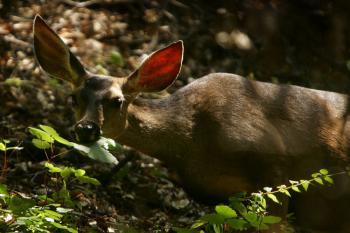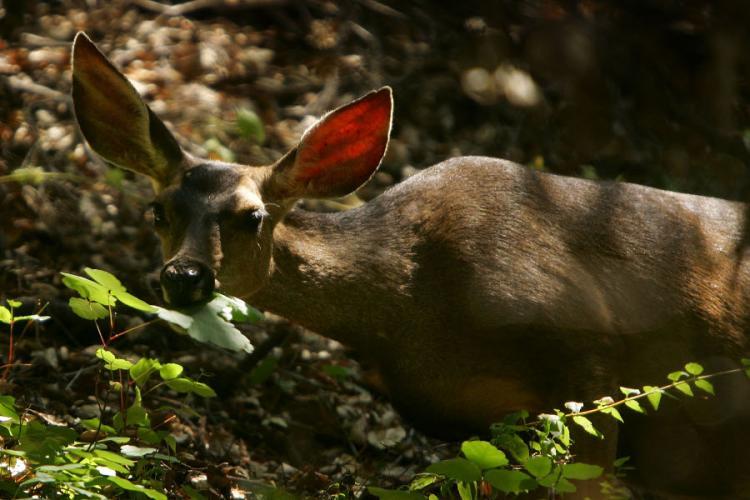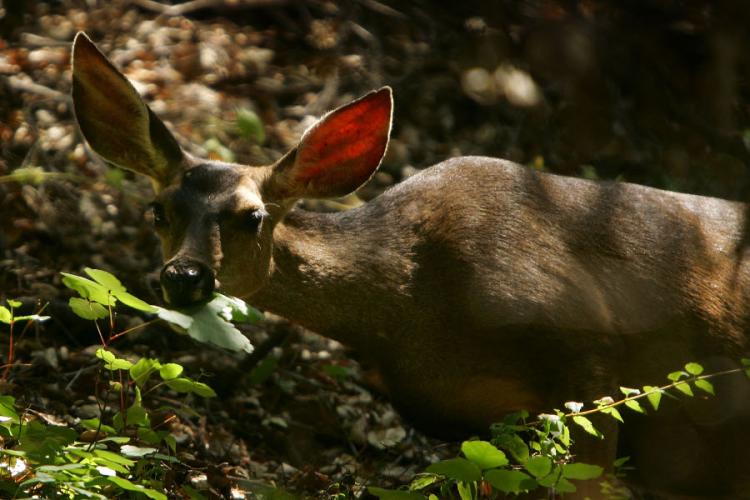Growing deer populations are fundamentally changing the environment of the Gulf Islands off the coast of British Columbia and Washington, leaving the region susceptible to invasion by foreign species, according to a study by researchers in the Faculty of Forestry at the University of British Columbia.
The researchers looked at the density of black-tailed deer on 18 Southern Gulf and San Juan Islands with forest ecosystems. The study, published Monday in the journal Biological Conservation, found that the number of birds and the amount of vegetation decreased on islands with higher deer densities.
Islands with more than one deer per hectare had half as many birds as those with low deer density.
Deer graze on shrubby vegetation for food—vegetation that songbirds such as hummingbirds, sparrows, and warblers depend on for nesting and feeding. The researchers found that islands with moderate or high deer density had less shrubby vegetation and half as many birds as those with low deer density, or one deer per square kilometer (247 acres).
“These changes are not the result of natural processes,” Tara Martin, adjunct professor in the Faculty of Forestry and lead author of the study, said in a release.
“The environmental changes are an indirect effect of humans. We’ve removed the large animals that preyed on deer and changed hunting policies,” said Martin, also a senior scientist with Australia’s Commonwealth Scientific and Industrial Research Organization.
The researchers suggest that changing regulations and sentiments toward deer hunting have allowed populations to thrive, and may lead to greater numbers of local plant and bird species on threatened species lists in the future.
“As plant species decline, it is inevitable that birds, insect pollinators, and other species will also decline,” said Peter Arcese, professor in the Faculty of Forestry and coauthor of the study.
“I work with several small island communities that have seen dramatic change firsthand but are prevented from hunting by local bans.”
The researchers suggest that by reducing or eliminating native plants, deer facilitate the invasion of non-native species and erode the natural beauty of the coastal Douglas fir forests on the Southern Gulf and San Juan Islands, reducing the biological integrity and aesthetic appeal of the region.
“We’re hoping to convince government that they need to consider new management initiatives, such as limited entry hunting under community supervision, because failing to act is a decision to favor the black-tailed deer over many other species native to our region and valued by humans,” said Arcese.
The researchers looked at the density of black-tailed deer on 18 Southern Gulf and San Juan Islands with forest ecosystems. The study, published Monday in the journal Biological Conservation, found that the number of birds and the amount of vegetation decreased on islands with higher deer densities.
Islands with more than one deer per hectare had half as many birds as those with low deer density.
Deer graze on shrubby vegetation for food—vegetation that songbirds such as hummingbirds, sparrows, and warblers depend on for nesting and feeding. The researchers found that islands with moderate or high deer density had less shrubby vegetation and half as many birds as those with low deer density, or one deer per square kilometer (247 acres).
“These changes are not the result of natural processes,” Tara Martin, adjunct professor in the Faculty of Forestry and lead author of the study, said in a release.
“The environmental changes are an indirect effect of humans. We’ve removed the large animals that preyed on deer and changed hunting policies,” said Martin, also a senior scientist with Australia’s Commonwealth Scientific and Industrial Research Organization.
The researchers suggest that changing regulations and sentiments toward deer hunting have allowed populations to thrive, and may lead to greater numbers of local plant and bird species on threatened species lists in the future.
“As plant species decline, it is inevitable that birds, insect pollinators, and other species will also decline,” said Peter Arcese, professor in the Faculty of Forestry and coauthor of the study.
“I work with several small island communities that have seen dramatic change firsthand but are prevented from hunting by local bans.”
The researchers suggest that by reducing or eliminating native plants, deer facilitate the invasion of non-native species and erode the natural beauty of the coastal Douglas fir forests on the Southern Gulf and San Juan Islands, reducing the biological integrity and aesthetic appeal of the region.
“We’re hoping to convince government that they need to consider new management initiatives, such as limited entry hunting under community supervision, because failing to act is a decision to favor the black-tailed deer over many other species native to our region and valued by humans,” said Arcese.







